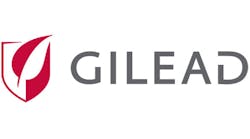John Milligan was the 32nd employee at Gilead Sciences Inc. (IW 500/45) when he was hired as a research scientist in 1990. Now, he’s at the helm of the biggest biotechnology firm in the world, charged with maintaining the company’s blistering pace of growth to satisfy investors anxious about a slowdown in its blockbuster hepatitis C treatments.
“It’s time for us to go out and do important deals,” Milligan, who became chief executive officer in March, said in an interview at Gilead’s headquarters in Foster City, Calif. “We need some other assets that can bolster our pipeline.”
The new CEO has inherited the drugmaker at a critical juncture. Sales of Gilead’s two hepatitis C pills -- among the fastest-selling drugs of all time -- fell for the first time last quarter as they face competing products, sparking concerns that the franchise will decline faster than predicted.
Milligan says he’s eager to score a key asset in cancer, one of the three therapeutic areas he seeks to expand alongside liver diseases and inflammatory disorders. His guiding question when surveying possible targets is: “What is going to be the cutting-edge technology five years from now, and would I be part of that?” To that end, he’s not limiting himself to any particular subset of cancer, like blood or solid tumors.
Gilead, whose only approved cancer drug, Zydelig, is limited in use because of its side effects, doesn’t have a key compound in-house. The company has a “nascent oncology platform, but what I don’t yet see is a drug that we can rally around,” the CEO said.
With $21.3 billion in cash and short-term equivalents on hand, Milligan has the firepower to spend big. The pressure is high to repeat the success his predecessor John Martin had with the $11 billion deal in 2011 that brought in hepatitis C drug Sovaldi, which helped double revenue in 2014.
While Milligan wouldn’t identify specific targets, Geoffrey Porges, an analyst at Leerink Partners LLC, estimates the CEO needs to find a product that would add $5 billion to $10 billion to revenue in the next five to 10 years to “move the needle.”
That’s not to say he’ll hit it every time, but over time this is a guy you want to bet on.”— Mark Schoenebaum, analyst, Evercore ISI
“In another era he would be considered one of the most respected executives in the entire industry, but unfortunately he’s sort of stepped into the leadership role at a very challenging time and effectively is having to re-prove himself,” said Porges, who rates Gilead outperform.
Gilead Sciences' Investors Are Wary
Investors have been wary about his next move. The shares have slipped 11% since Gilead posted lower-than-expected earnings last week as sales of Sovaldi and its successor, Harvoni, disappointed -- effectively ending Milligan’s “honeymoon,” Porges said.
Milligan, 55, is confident that the 25 years of lessons he’s learned watching Gilead grow from a tiny unknown biotech to a giant with annual sales of $33 billion will help him bring his company to the next level. Since joining straight out of a postdoctoral fellowship at the University of California at San Francisco, he’s risen through the echelons with roles including vice president of corporate development and chief financial officer, becoming chief operating officer in 2007 and adding the title of president in 2008.
As Martin’s second-in-command for eight years, Milligan got much credit for the company’s recent growth from investors, said Mark Schoenebaum, an analyst at Evercore ISI with a buy rating on Gilead: “That’s not to say he’ll hit it every time, but over time this is a guy you want to bet on.”
Besides looking for a key oncology deal, Milligan is investing in nonalcoholic steatohepatitis, a fatty liver disease known as NASH that affects more than 6 million patients in the U.S., according to the National Institutes of Health. Gilead has four experimental compounds aimed at NASH, including an early-stage drug bought last month for $400 million upfront, the first deal to be signed under Milligan’s tenure.
While the disease is relatively new to physicians and any drug approved may not immediately see widespread use, Milligan is willing to be patient.
“We will have to do quite a bit of work to study and understand the characteristics of what treatment of NASH means for a patient,” he said. “As an innovative company, it’s up to us to help prove it.”
In inflammatory disease, Gilead is pegging its hopes on filgotinib, developed in partnership with Belgian biotech firm Galapagos NV and currently being tested against rheumatoid arthritis and Crohn’s disease.
Crowded Market
The market is crowded: Celgene Inc. and AbbVie Inc. have extensive pipelines and products on the market. But Milligan is unfazed, pointing out that when Gilead’s first HIV product, Viread, was approved in 2001, it was the 15th therapy on the market, competing with treatments from Bristol-Myers Squibb Co., GlaxoSmithKline Plc and Merck & Co.
“So many groups back then didn’t give Gilead much credit because we were competing with such large pharmaceutical firms, and yet with the right drug and the right studies and scientific backing we showed that this could be a very important product and gradually won the market over,” he said.
The same goes for filgotinib and other novel inflammatory drugs. Filgotinib, an oral pill, may have an edge over the injectables on the market, being more convenient for patients to take, the CEO said.
Milligan is cautious about an area that in recent years has captured the imagination of physicians and investors: engineered T-cell therapies for cancer. The treatments involve removing patients’ immune cells, genetically engineering them to recognize the tumors, and restoring them to the patient. Startups Juno Therapeutics Inc. and Kite Pharma Inc. have attracted large biotech partners on the promise of these bespoke therapies.
“It’s a very labor-intensive kind of business,” Milligan said. “Those programs are projected to be quite expensive and are more akin to a bone marrow transplant, with a lot of supportive care and hospitalization costs, and those are the sorts of things that make me nervous.”
The CEO never intended to stay so long when he joined Gilead, which has now more than 8,000 employees: “I said to my wife that we’d probably move every four to five years, and about every five years she asks, ‘So, are we going or not?’”
Yet after spending his whole career with one employer, he still has the enthusiasm of a new hire.
“I want to guarantee the longevity of Gilead, so in 20 years, long after I’ve retired, for Gilead to still be a top-notch company,” he said.
By Caroline Chen




